warning Citroen BX HATCHBACK 1992 2.G Workshop Manual
[x] Cancel search | Manufacturer: CITROEN, Model Year: 1992, Model line: BX HATCHBACK, Model: Citroen BX HATCHBACK 1992 2.GPages: 16, PDF Size: 0.47 MB
Page 5 of 16
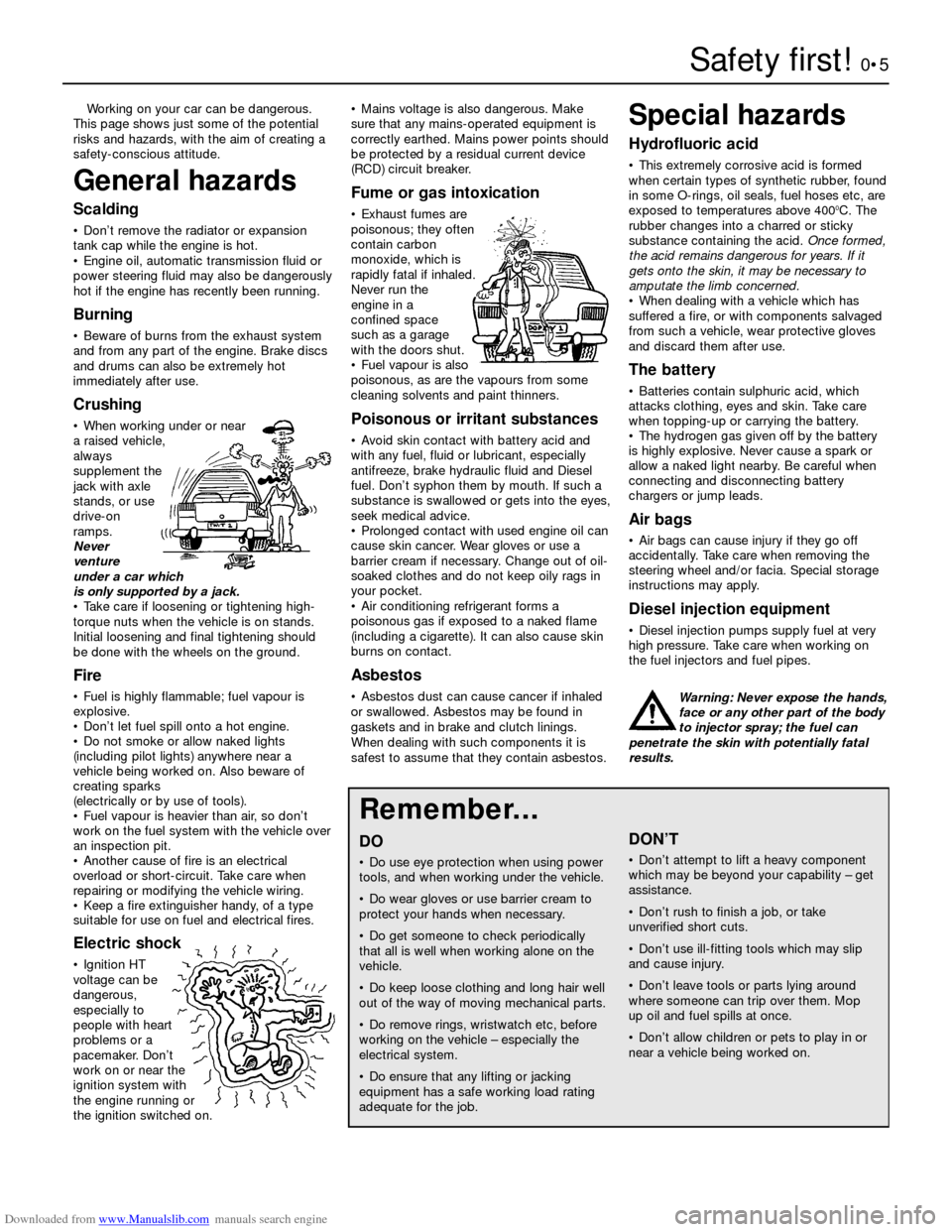
Downloaded from www.Manualslib.com manuals search engine Safety first!0•5
Working on your car can be dangerous.
This page shows just some of the potential
risks and hazards, with the aim of creating a
safety-conscious attitude.
General hazards
Scalding
• Don’t remove the radiator or expansion
tank cap while the engine is hot.
• Engine oil, automatic transmission fluid or
power steering fluid may also be dangerously
hot if the engine has recently been running.
Burning
• Beware of burns from the exhaust system
and from any part of the engine. Brake discs
and drums can also be extremely hot
immediately after use.
Crushing
• When working under or near
a raised vehicle,
always
supplement the
jack with axle
stands, or use
drive-on
ramps.
Never
venture
under a car which
is only supported by a jack.
• Take care if loosening or tightening high-
torque nuts when the vehicle is on stands.
Initial loosening and final tightening should
be done with the wheels on the ground.
Fire
• Fuel is highly flammable; fuel vapour is
explosive.
• Don’t let fuel spill onto a hot engine.
• Do not smoke or allow naked lights
(including pilot lights) anywhere near a
vehicle being worked on. Also beware of
creating sparks
(electrically or by use of tools).
• Fuel vapour is heavier than air, so don’t
work on the fuel system with the vehicle over
an inspection pit.
• Another cause of fire is an electrical
overload or short-circuit. Take care when
repairing or modifying the vehicle wiring.
• Keep a fire extinguisher handy, of a type
suitable for use on fuel and electrical fires.
Electric shock
• Ignition HT
voltage can be
dangerous,
especially to
people with heart
problems or a
pacemaker. Don’t
work on or near the
ignition system with
the engine running or
the ignition switched on.• Mains voltage is also dangerous. Make
sure that any mains-operated equipment is
correctly earthed. Mains power points should
be protected by a residual current device
(RCD) circuit breaker.
Fume or gas intoxication
• Exhaust fumes are
poisonous; they often
contain carbon
monoxide, which is
rapidly fatal if inhaled.
Never run the
engine in a
confined space
such as a garage
with the doors shut.
• Fuel vapour is also
poisonous, as are the vapours from some
cleaning solvents and paint thinners.
Poisonous or irritant substances
• Avoid skin contact with battery acid and
with any fuel, fluid or lubricant, especially
antifreeze, brake hydraulic fluid and Diesel
fuel. Don’t syphon them by mouth. If such a
substance is swallowed or gets into the eyes,
seek medical advice.
• Prolonged contact with used engine oil can
cause skin cancer. Wear gloves or use a
barrier cream if necessary. Change out of oil-
soaked clothes and do not keep oily rags in
your pocket.
• Air conditioning refrigerant forms a
poisonous gas if exposed to a naked flame
(including a cigarette). It can also cause skin
burns on contact.
Asbestos
• Asbestos dust can cause cancer if inhaled
or swallowed. Asbestos may be found in
gaskets and in brake and clutch linings.
When dealing with such components it is
safest to assume that they contain asbestos.
Special hazards
Hydrofluoric acid
• This extremely corrosive acid is formed
when certain types of synthetic rubber, found
in some O-rings, oil seals, fuel hoses etc, are
exposed to temperatures above 400
0C. The
rubber changes into a charred or sticky
substance containing the acid. Once formed,
the acid remains dangerous for years. If it
gets onto the skin, it may be necessary to
amputate the limb concerned.
• When dealing with a vehicle which has
suffered a fire, or with components salvaged
from such a vehicle, wear protective gloves
and discard them after use.
The battery
• Batteries contain sulphuric acid, which
attacks clothing, eyes and skin. Take care
when topping-up or carrying the battery.
• The hydrogen gas given off by the battery
is highly explosive. Never cause a spark or
allow a naked light nearby. Be careful when
connecting and disconnecting battery
chargers or jump leads.
Air bags
• Air bags can cause injury if they go off
accidentally. Take care when removing the
steering wheel and/or facia. Special storage
instructions may apply.
Diesel injection equipment
• Diesel injection pumps supply fuel at very
high pressure. Take care when working on
the fuel injectors and fuel pipes.
Warning: Never expose the hands,
face or any other part of the body
to injector spray; the fuel can
penetrate the skin with potentially fatal
results.
Remember...
DO
• Do use eye protection when using power
tools, and when working under the vehicle.
• Do wear gloves or use barrier cream to
protect your hands when necessary.
• Do get someone to check periodically
that all is well when working alone on the
vehicle.
• Do keep loose clothing and long hair well
out of the way of moving mechanical parts.
• Do remove rings, wristwatch etc, before
working on the vehicle – especially the
electrical system.
• Do ensure that any lifting or jacking
equipment has a safe working load rating
adequate for the job.
A few tips
DON’T
• Don’t attempt to lift a heavy component
which may be beyond your capability – get
assistance.
• Don’t rush to finish a job, or take
unverified short cuts.
• Don’t use ill-fitting tools which may slip
and cause injury.
• Don’t leave tools or parts lying around
where someone can trip over them. Mop
up oil and fuel spills at once.
• Don’t allow children or pets to play in or
near a vehicle being worked on.
Page 8 of 16
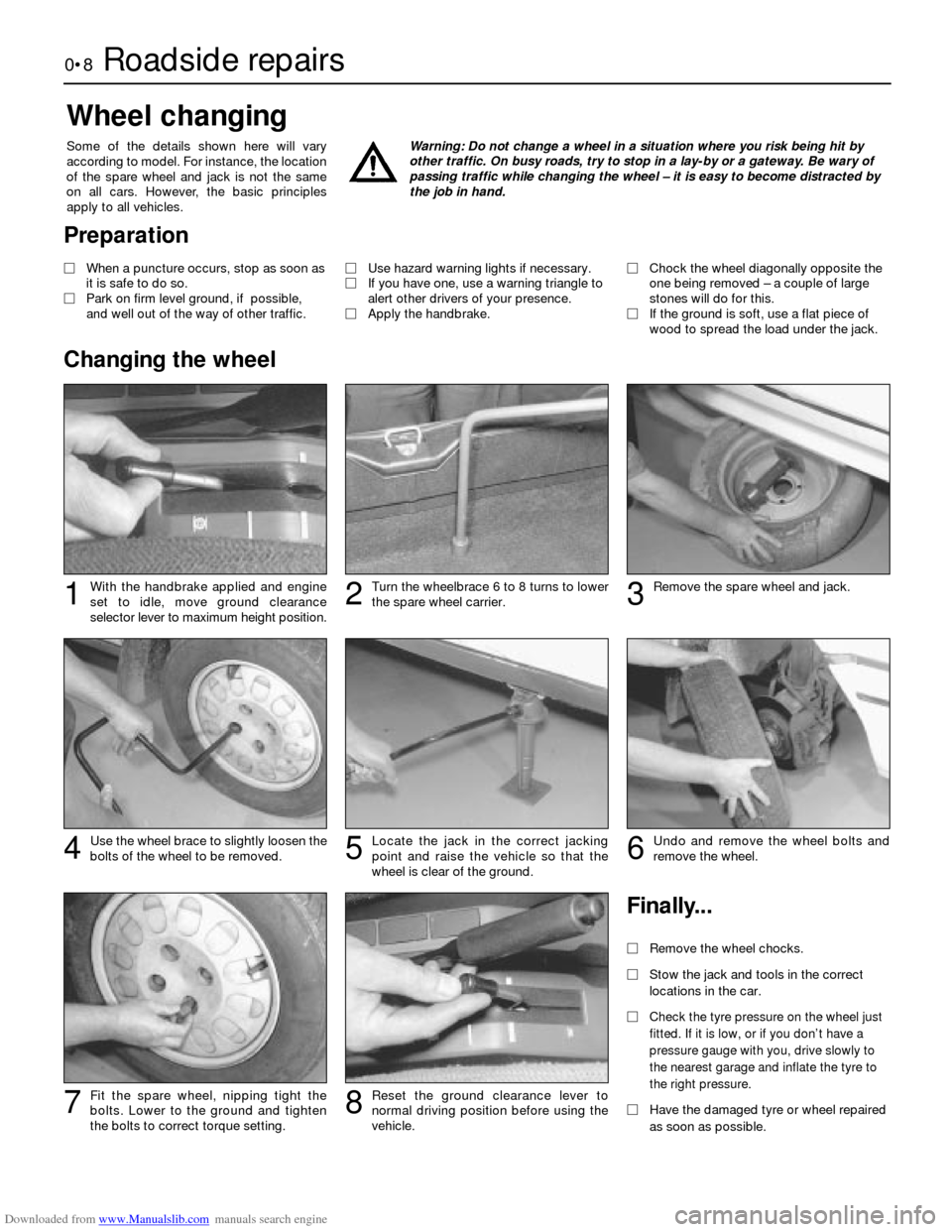
Downloaded from www.Manualslib.com manuals search engine 0•8Roadside repairs
With the handbrake applied and engine
set to idle, move ground clearance
selector lever to maximum height position.
Wheel changing
Some of the details shown here will vary
according to model. For instance, the location
of the spare wheel and jack is not the same
on all cars. However, the basic principles
apply to all vehicles.Warning: Do not change a wheel in a situation where you risk being hit by
other traffic. On busy roads, try to stop in a lay-by or a gateway. Be wary of
passing traffic while changing the wheel – it is easy to become distracted by
the job in hand.
Finally...
MRemove the wheel chocks.
MStow the jack and tools in the correct
locations in the car.
M
Check the tyre pressure on the wheel just
fitted. If it is low, or if you don’t have a
pressure gauge with you, drive slowly to
the nearest garage and inflate the tyre to
the right pressure.
MHave the damaged tyre or wheel repaired
as soon as possible.
Use the wheel brace to slightly loosen the
bolts of the wheel to be removed.Locate the jack in the correct jacking
point and raise the vehicle so that the
wheel is clear of the ground.Undo and remove the wheel bolts and
remove the wheel.
Remove the spare wheel and jack.Turn the wheelbrace 6 to 8 turns to lower
the spare wheel carrier.123
4
Fit the spare wheel, nipping tight the
bolts. Lower to the ground and tighten
the bolts to correct torque setting.7Reset the ground clearance lever to
normal driving position before using the
vehicle.8
56
Preparation
MWhen a puncture occurs, stop as soon as
it is safe to do so.
MPark on firm level ground, if possible,
and well out of the way of other traffic.MUse hazard warning lights if necessary.
MIf you have one, use a warning triangle to
alert other drivers of your presence.
MApply the handbrake.MChock the wheel diagonally opposite the
one being removed – a couple of large
stones will do for this.
MIf the ground is soft, use a flat piece of
wood to spread the load under the jack.
Changing the wheel
Page 9 of 16
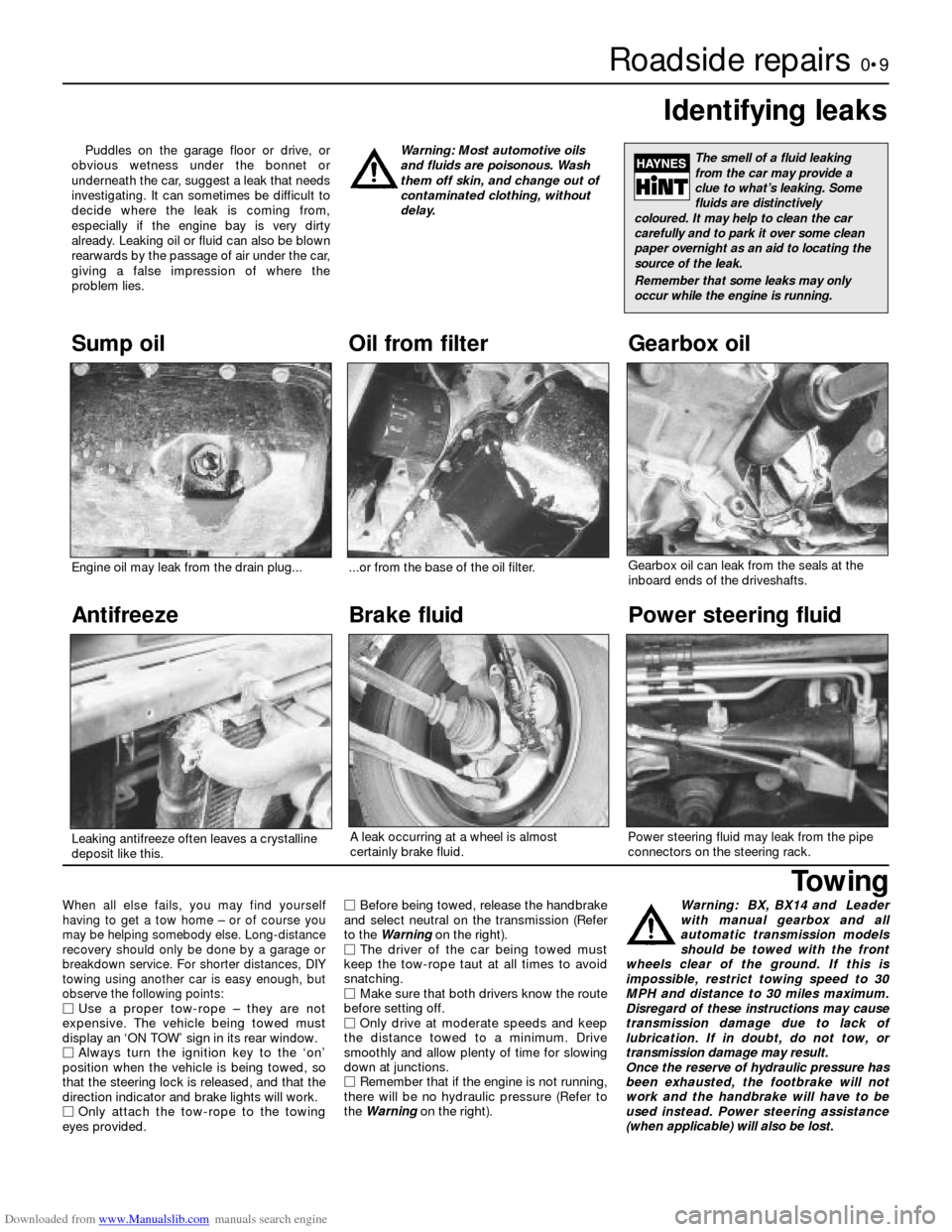
Downloaded from www.Manualslib.com manuals search engine Roadside repairs0•9
When all else fails, you may find yourself
having to get a tow home – or of course you
may be helping somebody else. Long-distance
recovery should only be done by a garage or
breakdown service. For shorter distances, DIY
towing using another car is easy enough, but
observe the following points:
MUse a proper tow-rope – they are not
expensive. The vehicle being towed must
display an ‘ON TOW’ sign in its rear window.
MAlways turn the ignition key to the ‘on’
position when the vehicle is being towed, so
that the steering lock is released, and that the
direction indicator and brake lights will work.
MOnly attach the tow-rope to the towing
eyes provided.MBefore being towed, release the handbrake
and select neutral on the transmission (Refer
to the Warningon the right).
MThe driver of the car being towed must
keep the tow-rope taut at all times to avoid
snatching.
MMake sure that both drivers know the route
before setting off.
MOnly drive at moderate speeds and keep
the distance towed to a minimum. Drive
smoothly and allow plenty of time for slowing
down at junctions.
MRemember that if the engine is not running,
there will be no hydraulic pressure (Refer to
the Warningon the right).Warning: BX, BX14 and Leader
with manual gearbox and all
automatic transmission models
should be towed with the front
wheels clear of the ground. If this is
impossible, restrict towing speed to 30
MPH and distance to 30 miles maximum.
Disregard of these instructions may cause
transmission damage due to lack of
lubrication. If in doubt, do not tow, or
transmission damage may result.
Once the reserve of hydraulic pressure has
been exhausted, the footbrake will not
work and the handbrake will have to be
used instead. Power steering assistance
(when applicable) will also be lost.
Towing
Puddles on the garage floor or drive, or
obvious wetness under the bonnet or
underneath the car, suggest a leak that needs
investigating. It can sometimes be difficult to
decide where the leak is coming from,
especially if the engine bay is very dirty
already. Leaking oil or fluid can also be blown
rearwards by the passage of air under the car,
giving a false impression of where the
problem lies.Warning: Most automotive oils
and fluids are poisonous. Wash
them off skin, and change out of
contaminated clothing, without
delay.
Identifying leaks
The smell of a fluid leaking
from the car may provide a
clue to what’s leaking. Some
fluids are distinctively
coloured. It may help to clean the car
carefully and to park it over some clean
paper overnight as an aid to locating the
source of the leak.
Remember that some leaks may only
occur while the engine is running.
Sump oil Gearbox oil
Brake fluid Power steering fluidOil from filter
Antifreeze
Engine oil may leak from the drain plug......or from the base of the oil filter.
Leaking antifreeze often leaves a crystalline
deposit like this.Gearbox oil can leak from the seals at the
inboard ends of the driveshafts.
A leak occurring at a wheel is almost
certainly brake fluid.Power steering fluid may leak from the pipe
connectors on the steering rack.
Page 10 of 16
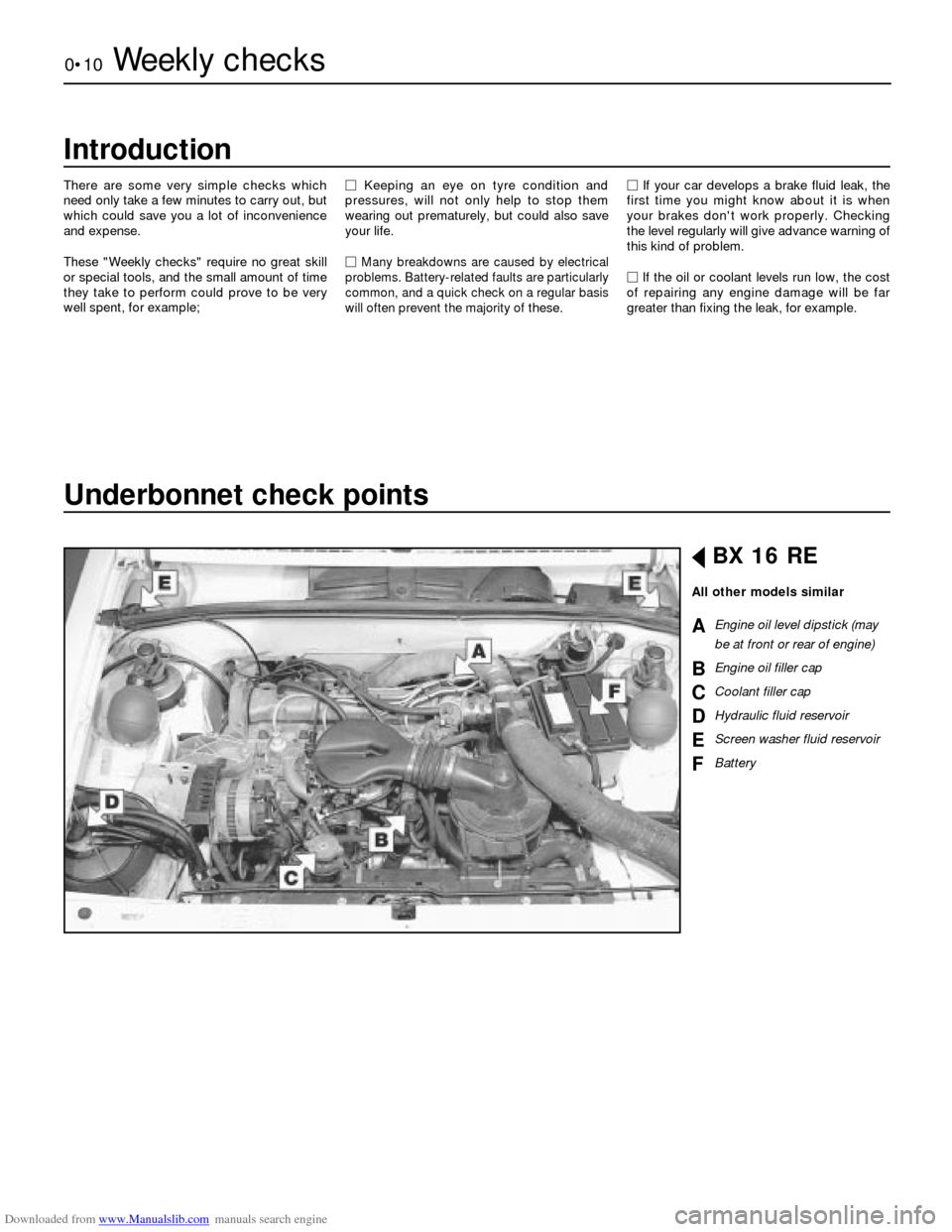
Downloaded from www.Manualslib.com manuals search engine 0•10Weekly checks
There are some very simple checks which
need only take a few minutes to carry out, but
which could save you a lot of inconvenience
and expense.
These "Weekly checks" require no great skill
or special tools, and the small amount of time
they take to perform could prove to be very
well spent, for example;MKeeping an eye on tyre condition and
pressures, will not only help to stop them
wearing out prematurely, but could also save
your life.
M
Many breakdowns are caused by electrical
problems. Battery-related faults are particularly
common, and a quick check on a regular basis
will often prevent the majority of
these.MIf your car develops a brake fluid leak, the
first time you might know about it is when
your brakes don't work properly. Checking
the level regularly will give advance warning of
this kind of problem.
MIf the oil or coolant levels run low, the cost
of repairing any engine damage will be far
greater than fixing the leak, for example.
Introduction
§BX 16 RE
All other models similar
AEngine oil level dipstick (may
be at front or rear of engine)
BEngine oil filler cap
CCoolant filler cap
DHydraulic fluid reservoir
EScreen washer fluid reservoir
FBattery
Underbonnet check points
Page 11 of 16
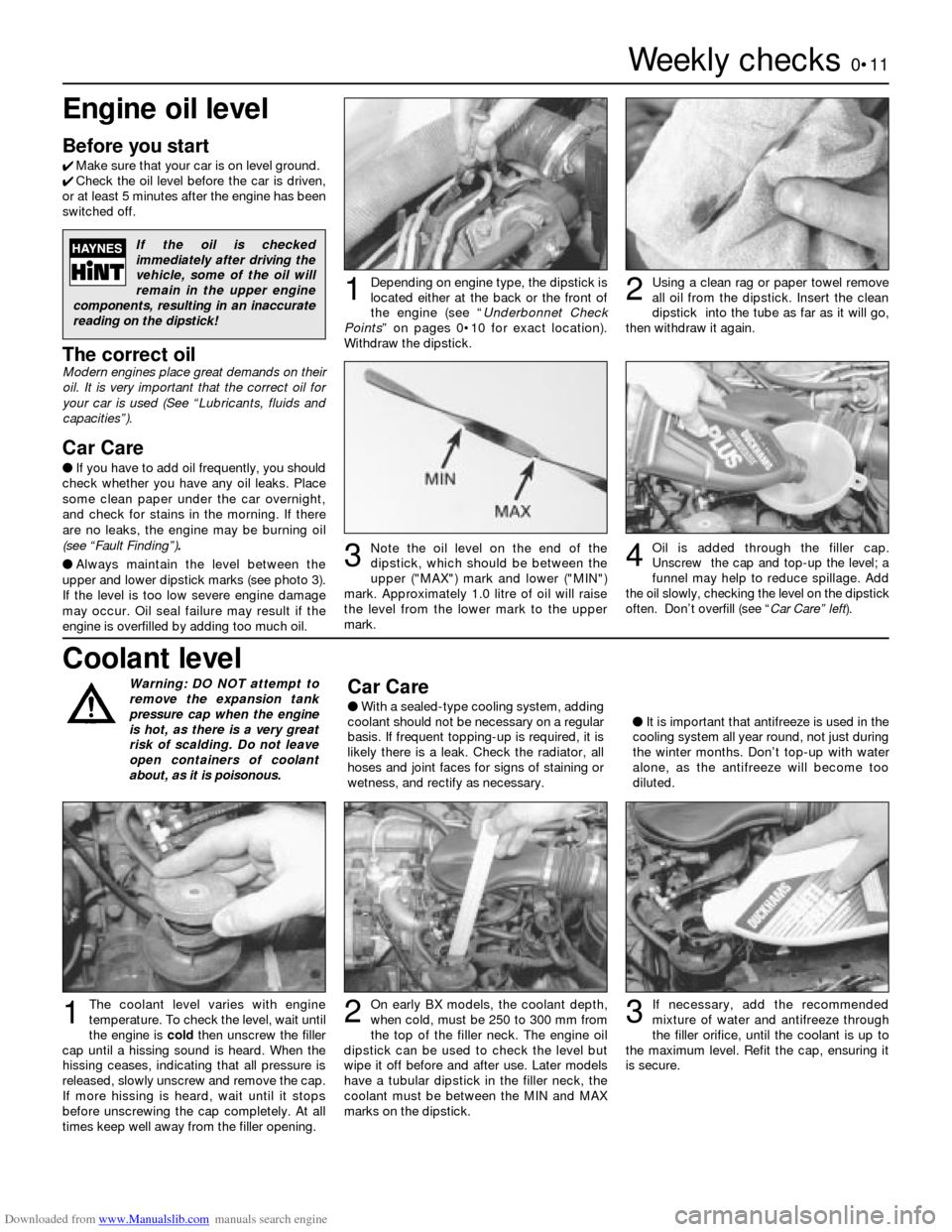
Downloaded from www.Manualslib.com manuals search engine Weekly checks0•11
Engine oil level
Before you start
4Make sure that your car is on level ground.
4Check the oil level before the car is driven,
or at least 5 minutes after the engine has been
switched off.
The correct oilModern engines place great demands on their
oil. It is very important that the correct oil for
your car is used (See “Lubricants, fluids and
capacities”).
Car Care
l If you have to add oil frequently, you should
check whether you have any oil leaks. Place
some clean paper under the car overnight,
and check for stains in the morning. If there
are no leaks, the engine may be burning oil
(see “Fault Finding”).
lAlways maintain the level between the
upper and lower dipstick marks (see photo 3).
If the level is too low severe engine damage
may occur. Oil seal failure may result if the
engine is overfilled by adding too much oil.
If the oil is checked
immediately after driving the
vehicle, some of the oil will
remain in the upper engine
components, resulting in an inaccurate
reading on the dipstick!
Depending on engine type, the dipstick is
located either at the back or the front of
the engine (see “Underbonnet Check
Points” on pages 0•10 for exact location).
Withdraw the dipstick.Using a clean rag or paper towel remove
all oil from the dipstick. Insert the clean
dipstick into the tube as far as it will go,
then withdraw it again.
Note the oil level on the end of the
dipstick, which should be between the
upper ("MAX") mark and lower ("MIN")
mark. Approximately 1.0 litre of oil will raise
the level from the lower mark to the upper
mark.Oil is added through the filler cap.
Unscrew the cap and top-up the level; a
funnel may help to reduce spillage. Add
the oil slowly, checking the level on the dipstick
often. Don’t overfill (see “Car Care” left).
12
34
Warning: DO NOT attempt to
remove the expansion tank
pressure cap when the engine
is hot, as there is a very great
risk of scalding. Do not leave
open containers of coolant
about, as it is poisonous.Car Care
lWith a sealed-type cooling system, adding
coolant should not be necessary on a regular
basis. If frequent topping-up is required, it is
likely there is a leak. Check the radiator, all
hoses and joint faces for signs of staining or
wetness, and rectify as necessary.lIt is important that antifreeze is used in the
cooling system all year round, not just during
the winter months. Don’t top-up with water
alone, as the antifreeze will become too
diluted.
Coolant level
The coolant level varies with engine
temperature. To check the level, wait until
the engine is cold then unscrew the filler
cap until a hissing sound is heard. When the
hissing ceases, indicating that all pressure is
released, slowly unscrew and remove the cap.
If more hissing is heard, wait until it stops
before unscrewing the cap completely. At all
times keep well away from the filler opening.On early BX models, the coolant depth,
when cold, must be 250 to 300 mm from
the top of the filler neck. The engine oil
dipstick can be used to check the level but
wipe it off before and after use. Later models
have a tubular dipstick in the filler neck, the
coolant must be between the MIN and MAX
marks on the dipstick.If necessary, add the recommended
mixture of water and antifreeze through
the filler orifice, until the coolant is up to
the maximum level. Refit the cap, ensuring it
is secure.123
Page 12 of 16
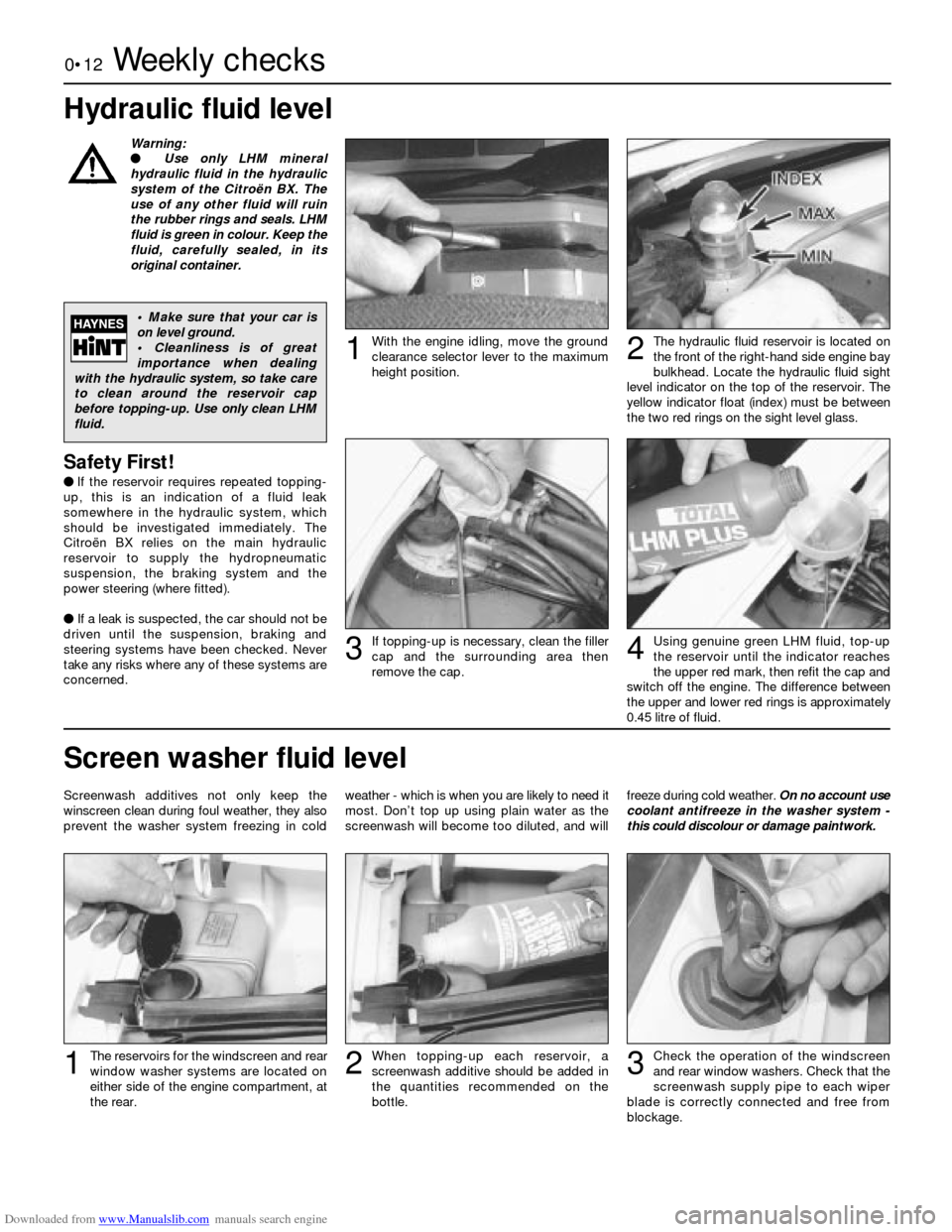
Downloaded from www.Manualslib.com manuals search engine 0•12Weekly checks
Hydraulic fluid level
Warning:
l Use only LHM mineral
hydraulic fluid in the hydraulic
system of the Citroën BX. The
use of any other fluid will ruin
the rubber rings and seals. LHM
fluid is green in colour. Keep the
fluid, carefully sealed, in its
original container.
Safety First!
lIf the reservoir requires repeated topping-
up, this is an indication of a fluid leak
somewhere in the hydraulic system, which
should be investigated immediately. The
Citroën BX relies on the main hydraulic
reservoir to supply the hydropneumatic
suspension, the braking system and the
power steering (where fitted).
lIf a leak is suspected, the car should not be
driven until the suspension, braking and
steering systems have been checked. Never
take any risks where any of these systems are
concerned.
• Make sure that your car is
on level ground.
• Cleanliness is of great
importance when dealing
with the hydraulic system, so take care
to clean around the reservoir cap
before topping-up. Use only clean LHM
fluid.
With the engine idling, move the ground
clearance selector lever to the maximum
height position.1The hydraulic fluid reservoir is located on
the front of the right-hand side engine bay
bulkhead. Locate the hydraulic fluid sight
level indicator on the top of the reservoir. The
yellow indicator float (index) must be between
the two red rings on the sight level glass.2
If topping-up is necessary, clean the filler
cap and the surrounding area then
remove the cap.3Using genuine green LHM fluid, top-up
the reservoir until the indicator reaches
the upper red mark, then refit the cap and
switch off the engine. The difference between
the upper and lower red rings is approximately
0.45 litre of fluid.4
Screenwash additives not only keep the
winscreen clean during foul weather, they also
prevent the washer system freezing in coldweather - which is when you are likely to need it
most. Don’t top up using plain water as the
screenwash will become too diluted, and willfreeze during cold weather. On no account use
coolant antifreeze in the washer system -
this could discolour or damage paintwork.
Screen washer fluid level
When topping-up each reservoir, a
screenwash additive should be added in
the quantities recommended on the
bottle.2The reservoirs for the windscreen and rear
window washer systems are located on
either side of the engine compartment, at
the rear.1Check the operation of the windscreen
and rear window washers. Check that the
screenwash supply pipe to each wiper
blade is correctly connected and free from
blockage.3